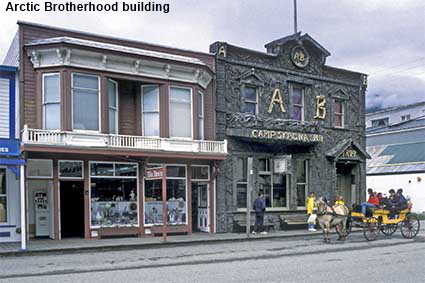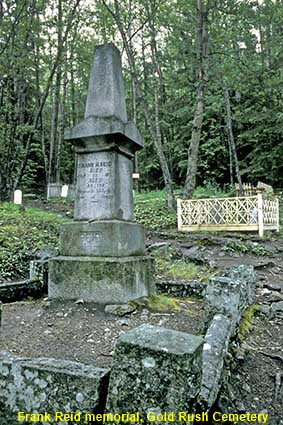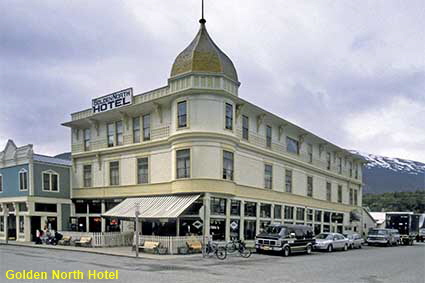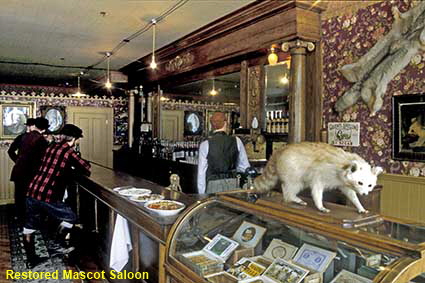Skagway
Skagway is a product of the 1897 Klondike Gold Rush. Prior to the Gold Rush there was little here yet by 1898 its proximity to the White Pass route into Canada’s Yukon had boosted the population to over 10,000. Bust inevitably followed the Gold Rush boom but Yukon proved to have riches other than gold and a slimmed down Skagway survived as a gateway to its mines. It has been restored to rekindle the atmosphere of a gold rush town, although it now exists primarily for the benefit of tourists from cruise ships. The town can be busy and the historic Red Onion Saloon still serves plenty of beer and food, but the throngs evaporate quickly when sailing time approaches.
Golden North Hotel
Built in 1898 at the height of the Gold Rush, the Golden North Hotel is the oldest hotel still operating in Alaska. The town shrank after the Gold Rush and the hotel was moved to its current location in 1908 at which time its distinctive dome was added. The hotel claims to have two ghosts, one the ghost of a young woman who died in Room 23 while waiting for her loved one to return from the gold fields.
Frank Reid memorial, Gold Rush Cemetery
The Skagway of the Gold Rush era was a lawless place. The leading villain in 1898 was called Jefferson “Soapy” Smith. He had gained his nickname back in Leadville Colorado selling overpriced bars of soap by conning people into believing that they might find $100 bills in them. With the law after him, he moved to Skagway. There he continued his dubious career, even running a telegraph office where miners could telegraph details of their finds and even receive ‘replies’, at a time when Skagway had no telegraph links. Soapy rose to control most of the illegal activities in the town so surveyor Frank Reid set up a town meeting to discuss how to deal with him. But Soapy turned up at the meeting with a gun and he and Reid exchanged fire. Soapy was killed outright and Reid died a hero a few days later from his wounds.
Arctic Brotherhood building
The buildings in Skagway do have the feel of a Gold Rush town. OK, the streets are now surfaced (paved), but you can still imagine the place full of prospectors. Perhaps the most quirky building in town is the Arctic Brotherhood building. The brotherhood was set up by 11 men in 1899 while travelling from Seattle to Skagway. In the gold rush era many buildings were constructed from driftwood, and the Arctic Brotherhood building is the last remaining example.
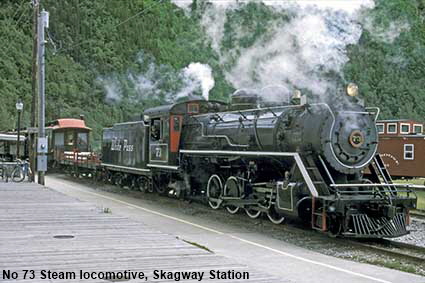
Restored Mascot Saloon
The Mascot Saloon goes right back to the gold rush days. Prohibition forced it to become a drug store, but it has now been restored to its late 19th century appearance. Unlike the Red Onion the Mascot is no longer a functioning saloon - it is just for display, which is why every photograph of it shows the same customers in the same positions! Incidentally, the customer just visible on the left at the very back is the notorious Soapy Smith.
DLU060107
Click on Minimap to navigate


To move forwards or backwards through the Alaska trail click the arrows above, or select your next destination on the Minimap.
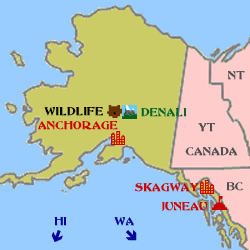
No 73 Steam locomotive, Skagway Station
Surviving pictures of heavily overloaded prospectors struggling up steep and icy slopes give a feel for the challenges faced during the Klondike gold rush in 1897. The 180 km (112 mile) long White Pass & Yukon Railroad was started in 1898 and finished in 1900. It linked Skagway with Whitehorse in the Yukon providing a passenger service and supply line to the mines. Mine closures led in 1982 to closure of the line, but it reopened in 1988 as a tourist line. Although most trips are diesel hauled, the railroad still has one working steam engine, No. 73, a 1947 Baldwin locomotive, and we were lucky enough to see it in steam. Click on Tab 2 to see the less fortunate WP&YR locomotive No. 52.

© Mike Elsden 1981 - 2025
The contents of this page may not be reproduced in full or in part without permission
